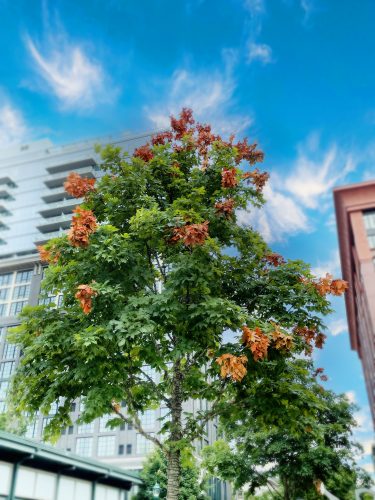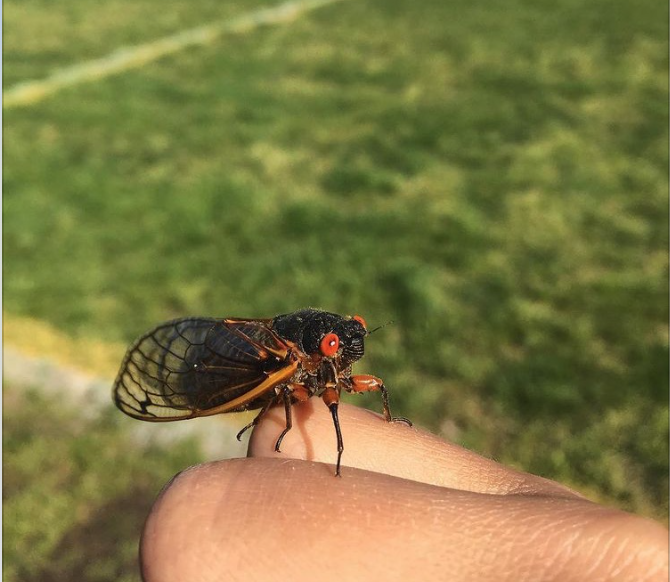
Sunflower Fields in Poolesville Have Started to Bloom
McKee-Beshers Wildlife Management Area, located off of River Road, is home to fields of sunflowers. In recent years, these sunflower fields have become a popular spot for people to visit– usually to take photos of the blooms or to use as a creative background.
Often, the sunflowers are in peak bloom around mid-July. However, there is some variety from year to year when peak bloom will occur– the Department of Natural Resources website explains that many factors affect the timing of the blooms, such as the techniques used in planting, type of seeds used, conditions of the soil, and more.
Although the sunflower fields are a popular spot for people to visit, that is not the main purpose behind why they are planted. They are primarily used for their seeds, which are cultivated to feed mourning doves and other types of animals that are hunted on the property. Additionally, the local bee population benefits from the pollen and nectar produced by these flowers.
While people are allowed to visit and take photos with the sunflowers, there are some rules that need to be followed: visitors are not allowed to cut, destroy, remove, or trample any of the sunflowers or other plants in the area.
You can learn more about the Mckee-Beshers sunflowers here.
By: Michelle Katz @pike.and.rozay
Why Do So Many Trees Look Like This Right Now? We Have the Answer– and It’s Cicadas
Have you noticed trees with clusters of brown leaves? This is known as branch flagging, and it’s happening to a lot of trees in our area right now.

Why is this happening? The Brood X cicadas were out and about in our area recently. When the female cicadas laid their eggs, they cut small slits into tree branches and deposited their eggs inside these slits. The branches that have eggs inside have started to wilt and their leaves have turned brown.
Only the branches that have eggs in them have been affected– they will eventually fall off, leaving healthy branches behind and the rest of the tree unharmed. Trees that are very young or delicate might not survive after this, but most trees will be fine.
Branch flagging can sometimes be caused by other pests such as scales, fungus, or other insects. In these instances, an increasing number of branches will start to show signs of flagging, and treatment may be required in order to keep the tree healthy. However, if the flagging is caused by cicadas no treatment for the tree is needed.
By: Michelle Katz @pike.and.rozay

The Cicadas Are Coming… Get Ready!
If you were in this area in the early 2000s (or mid 80s) you might remember one spring where there were cicadas everywhere. These periodical cicadas, who are part of a group known as Brood X, only come out once every 17 years. You might have guessed it… they’re due for a visit this year.
These particular cicadas have a 17 year life cycle and spend most of it living as nymphs underground. Experts believe that they’ve evolved to emerge all at once because their overwhelming group presence prevents them from being eaten by predators. They would be considered easy targets otherwise due to their loud noises and larger size.
We can expect these cicadas to emerge in mid-May and stick around until the end of June– they tend to come out once the ground warms up to around 65 degrees Fahrenheit and the air is around 80 degrees.
Maryland also has cicadas that come around annually, often called “dog day cicadas.” These annual cicadas look very different from the 17 year cicadas that we’re expecting this year. The 17 year cicadas are orange and black, whereas the annual cicadas are dark green.
Our area isn’t the only one getting a visit– these cicadas are known to live in 15 states in the Eastern US spanning from Georgia to Michigan and out West a little to Ohio, Tennessee, and Kentucky.
Fun fact: cicadas are not poisonous to humans– they are actually edible and are considered a good source of protein by some. Experts say that they are not poisonous to dogs either, although eating too many of them might upset their stomach.
For the most part, cicadas do not cause much damage to plants. They do not eat leaves– instead they drink sap from branches and roots, which does not harm most plants. If you wish to protect your younger trees and plants, it is recommended that you put foil around the trunk of the tree (to keep them from crawling up), using insect barrier tape, or using insect barrier netting over your tree.
Brood X information courtesy of https://www.cicadamania.com/ and University of Maryland’s Home and Garden Information Center.
Featured photo courtesy of Kelly Holland @keeneyedkelly
By: Michelle Katz @pike.and.rozay

